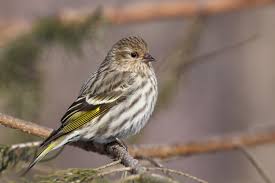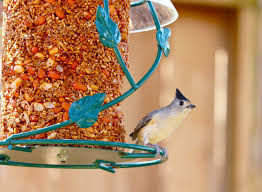The British naturalist James Fisher wrote that the first person recorded as feeding wild birds was the 6th-century monk Saint Serf of Fife who tamed a pigeon by feeding it, but the first indication of bird feeding in United States came from Henry David Thoreau who fed birds on Walden Pond in 1845. The first commercial bird feeder was a hummingbird feeder designed by Laurence J. Webster of Boston for his wife, who had read a 1928 National Geographic story about feeding hummers from small glass bottles. Since those times a profusion of bird feeders have been developed.
Bird feeding is enjoyable, a benefit both to people and the birds, but there can be a downside. A recent disease outbreak is killing finches across the western United States. Dead birds have been found in recent weeks in the Carson Valley and Truckee, California, the fatalities seeming to be related to an outbreak of salmonellosis, caused by Salmonella bacteria. A common cause of mortality in feeder birds, the symptoms are not always obvious. Sick birds may appear thin, fluffed up, and depressed and may have pasted vents and swollen eyelids. They are often lethargic and easy to approach. The problem appears to be especially bad along coastal Northern California, Oregon and Washington. Most of the affected birds are Pine Siskins, but Lesser Goldfinch and other finches may be affected. The bacteria are spread through droppings, especially where bird seed piles up beneath feeders or in tray feeders where the birds stand among the seeds.

The four diseases that most frequently affect birds that use feeders are: salmonella, caused by a bacterium, trichomoniasis, caused by one-celled protozoa, aspergillosis, a fungus, and avian pox, a virus. All of these diseases are transmitted from one bird to another at feeding stations, especially when overcrowding occurs. Birds are also susceptible to mites and lice which feed on the skin, the feathers, or suck blood. Birds infected with House Finch eye disease (also called Mycoplasmal conjunctivitis) have red, swollen, runny, or crusty eyes.
In addition to salmonella, some bird diseases are transmissible to humans, such as West Nile Virus (via mosquitoes), histoplasmosis, and campylobacteriosis, but they are typically not serious. But, to stay safe, wear rubber gloves when handling a dead or diseased bird or cleaning bird feeders.
To avoid diseases from spreading, keep your feeders clean. Clean them with a 9 to 1 solution of water to bleach at least once a week and let them dry thoroughly. Some people alternate feeders while one is being cleaned. Clean ground of any food accumulating under feeders. If you see sick or dead birds, consider removing the feeder for a couple of weeks. Don’t worry, the birds will find alternate sources of food.

Diseases at bird feeders are spread primarily by crowding. The more birds sharing the space, the more disease is likely to be spread. Some people say to avoid disease transmission, put up more feeders to spread the birds out, but I suggest taking all feeders down for a week and cleaning them.
Interesting about the droppings on fallen seeds under feeders. Also interesting about the origins of bird feeding. Actually, I’ve read your blog before and always found it interesting. I’m surprised you don’t get more comments. Your piece about bird brain density was thought provoking and made me wonder about differences between midbrains. Anyway, thanks for your work.
Thank you
Pingback: Baiting - The Norfolk Photographer